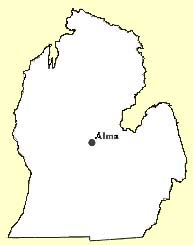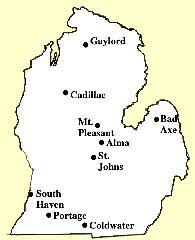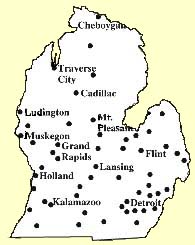
WalMart Locations, 1990
The advantages for WalMart of small town locations have been numerous--there has been virtually no competition from small local retailers; municipalities have had few regulations over land development and were generally very receptive to the increased tax base created by a large retailer; and access from surrounding communities has been relatively convenient via the interstate highway system, which now criss-crosses much of the rural countryside.

Five years later, the first twelve WalMart stores were opened in Michigan. They were located in smaller cities, including Alma, Bad Axe, and Coldwater. These locations didn't have direct competition from Meijers and KMart, and WalMart could easily establish retail dominance in those regions.

By 1995, a total of 53 WalMart stores have been opened in the state. They now include a large number in the larger metropolitan areas, where they were able to compete head to head with Meijers and KMart. This is especially significant growth over such a short time span, especially because both Meijers and KMart have a distinct advantage with their national headquarters located in Michigan, (Meijers in Grand Rapids and KMart in Troy), while WalMart's headquarters are located in distant Bentonville, Arkansas.

1 John Gruidl and Steven Kline. "What Happens When a Large Discount Store Comes to Town?" Small Town. March-April 1992. pp. 20-23.
2 Source: 1995 Chain Store Directory.
3 Store locations taken from Directory of Discount Stores, published by Business Guides, Inc.; maps drawn by Norman Tyler.
| Impact of Wal-Mart | Kenneth Stone Study of Wal-Mart |
|---|
| Strategies to cope with Wal-Mart | Case Study: Carroll, Iowa |
|---|
